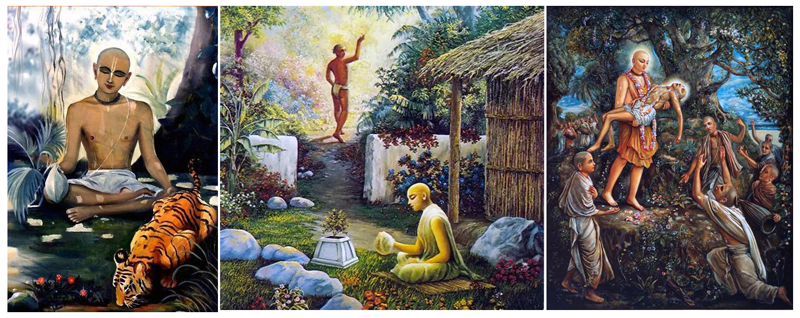
The Namācārya of the Holy Name
Introduction
Śrīla Haridāsa Ṭhākura is one of the most celebrated saints in the Gauḍīya Vaiṣṇava tradition. Born in 15th-century Bengal in a Muslim family, he became the Namācārya—the ācārya of the holy name—personally recognized by Lord Śrī Caitanya Mahāprabhu. His life exemplifies the unlimited mercy of Lord Kṛṣṇa’s holy names, which transcend all social, cultural, and religious boundaries.
ISKCON honors Śrīla Haridāsa Ṭhākura as a shining example of humility, tolerance, and unflinching faith in the chanting of the Hare Kṛṣṇa mahā-mantra.
Birth and Early Life
- Born in Budhana village in present-day Bangladesh, Haridāsa was raised in a Muslim household.
- Despite his background, he was irresistibly drawn to the chanting of the Lord’s names and soon became a dedicated Vaiṣṇava.
- His conversion was not a rejection of his past, but a testimony that the holy name of Kṛṣṇa is universal and open for all living beings, irrespective of birth or background.
The Namācārya – Chanting Without Limit
Śrīla Haridāsa Ṭhākura made a lifelong vow to chant 300,000 names of Kṛṣṇa every day (that is, 192 rounds of japa on beads).
He spent day and night in constant absorption, showing by example the supreme importance of nāma-saṅkīrtana (congregational chanting).
Lord Caitanya Mahāprabhu Himself gave him the title Namācārya, declaring him the teacher of the holy name for all time.
Severe Tests of Faith
Trial by the Qazi
The Muslim rulers of his time were enraged by his chanting. He was ordered to recite the Kalma and abandon chanting Kṛṣṇa’s names.
Haridāsa boldly declared:
“You may cut my body into pieces, but I will never stop chanting the holy name of Lord Hari.”
Beaten in 22 Marketplaces
As punishment, he was whipped and dragged through 22 marketplaces.
- Miraculously, although his body was torn and bruised, he remained alive, continuously chanting.
- This divine protection revealed the supremacy of the holy name.
The Prostitute Test
A notorious story describes how envious men sent a prostitute to seduce Haridāsa Ṭhākura.
- She approached him at night, but Haridāsa requested her to wait until he completed his daily quota of chanting.
- Night after night, she sat listening to his japa.
- The pure vibrations of the holy name melted her heart. Instead of distracting him, she was transformed into a devotee, renouncing her previous life.
Haridāsa gave her simple instructions:
- Chant the holy names constantly.
- Live a life of humility and devotion.
Thus, Haridāsa showed the transformative power of the holy name, capable of purifying even the most fallen.
Teachings on the Holy Name
Śrīla Haridāsa Ṭhākura emphasized three levels of chanting:
- Nāma-aparādha – chanting with offenses.
- Nāma-ābhāsa – the shadow of the holy name, which can grant liberation.
- Śuddha-nāma – pure chanting, which bestows love of God (prema-bhakti).
He proclaimed that even a faint glimpse of chanting (nāma-ābhāsa) can free one from bondage, while pure chanting delivers direct love of Kṛṣṇa.
Haridāsa and Lord Caitanya in Puri
In his later years, Haridāsa resided at Siddha Bakul, near the Jagannātha temple in Puri.
- As a Muslim by birth, he never entered the temple, but Lord Jagannātha personally came to him in the form of Lord Caitanya.
- Mahāprabhu would daily send Jagannātha’s prasāda to Haridāsa, honoring his humility and devotion.
The Glorious Departure
As Haridāsa Ṭhākura grew older, he desired to leave this world while gazing upon the lotus face of Lord Caitanya and chanting the holy name.
Disappearance of Śrīla Haridāsa Ṭhākura
- He departed from this world on the Ananta Caturdaśī day (the 14th day of the bright fortnight of Bhādra month, August–September).
- The year of his disappearance is 1531 CE in Jagannātha Purī.
Lord Caitanya Mahāprabhu personally fulfilled Haridāsa’s last wish:
- He gazed upon the Lord’s lotus face.
- Placed the feet of Mahāprabhu on his chest.
- And chanted “Śrī Kṛṣṇa Caitanya” until he left his body.
Mahāprabhu carried his body in His own arms, danced in ecstasy, and performed a glorious funeral at the seashore of Jagannātha Purī.
His samādhi (tomb) is still present on the seashore near Jagannātha Mandir in Puri, known as Śrī Haridāsa Ṭhākura Samādhi Mandir, and is visited by pilgrims worldwide.
Relevance for ISKCON Devotees Today
Śrīla Haridāsa Ṭhākura’s life is a timeless message for all devotees:
- Chanting is the essence – success in spiritual life depends on sincere absorption in the holy name.
- Humility and tolerance – Haridāsa never retaliated against persecution, embodying the qualities Mahāprabhu taught: tṛṇād api sunīcena.
- Compassion – his mercy transformed even a prostitute into a saintly devotee, showing us that no one is beyond redemption.
- Faith beyond externals – Haridāsa’s life proves that bhakti is not bound by caste, creed, or nationality.
The Real Form of Śrīla Haridāsa Ṭhākura
In Kṛṣṇa-līlā, he is said to be a combined incarnation of:
- Brahmā, the secondary creator of the universe, who once offended Kṛṣṇa in Vṛndāvana and later appeared as Haridāsa to perfectly glorify the holy name as atonement.
- Prahlāda Mahārāja, the great devotee of Lord Nṛsiṁhadeva, known for his fearless devotion despite severe persecution.
Thus, Haridāsa Ṭhākura represents fearless devotion (Prahlāda) and unceasing glorification of the Lord (Brahmā) combined in one personality.
Conclusion
Śrīla Haridāsa Ṭhākura is a beacon of hope in the age of Kali. His example assures us that, regardless of our past or present condition, by sincerely chanting the Hare Kṛṣṇa Mahā-mantra we can attain the highest goal of life—pure love for Kṛṣṇa.
On his appearance and disappearance days, ISKCON devotees worldwide honor his legacy through kathās, extra rounds of japa, and kīrtanas, remembering that he is our eternal Namācārya.
📿
“Hare Kṛṣṇa Hare Kṛṣṇa Kṛṣṇa Kṛṣṇa Hare Hare
Hare Rāma Hare Rāma Rāma Rāma Hare Hare”
